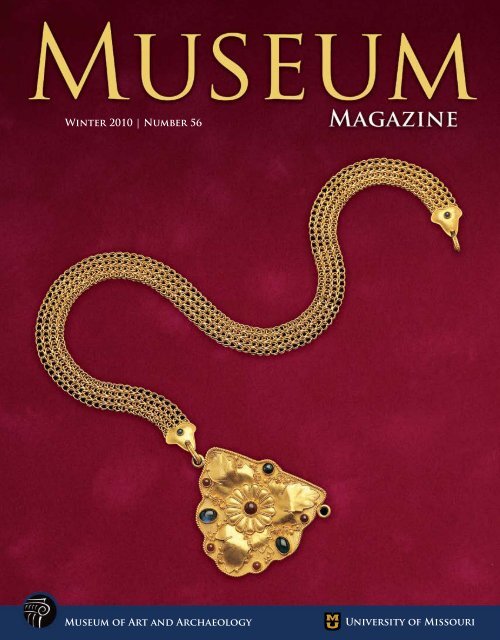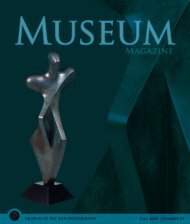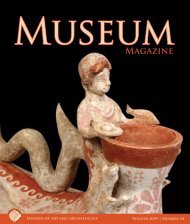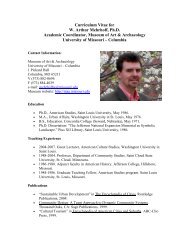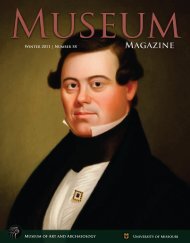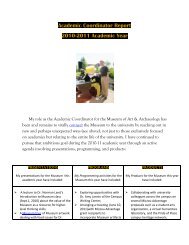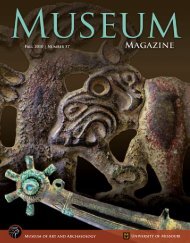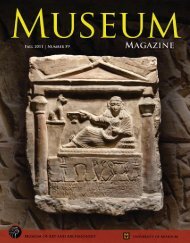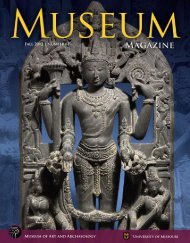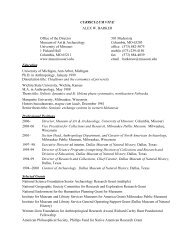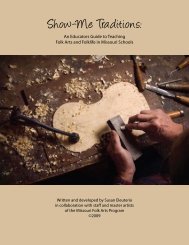Winter 2010 - Museum of Art and Archaeology - University of Missouri
Winter 2010 - Museum of Art and Archaeology - University of Missouri
Winter 2010 - Museum of Art and Archaeology - University of Missouri
You also want an ePaper? Increase the reach of your titles
YUMPU automatically turns print PDFs into web optimized ePapers that Google loves.
<strong>Winter</strong> <strong>2010</strong> | Number 56<br />
<strong>Museum</strong> <strong>of</strong> <strong>Art</strong> <strong>and</strong> <strong>Archaeology</strong><br />
<strong>University</strong> <strong>of</strong> <strong>Missouri</strong>
Contents<br />
Mission Statement<br />
The <strong>Museum</strong> <strong>of</strong> <strong>Art</strong> <strong>and</strong> <strong>Archaeology</strong> advances<br />
underst<strong>and</strong>ing <strong>of</strong> our artistic <strong>and</strong> cultural heritage<br />
through research, collection <strong>and</strong> interpretation. We<br />
help students, scholars <strong>and</strong> the broader community<br />
to experience authentic <strong>and</strong> significant art <strong>and</strong><br />
artifacts firsth<strong>and</strong>, <strong>and</strong> to place them in meaningful<br />
contexts. We further this mission by preserving,<br />
enhancing <strong>and</strong> providing access to the collections<br />
for the benefit <strong>of</strong> present <strong>and</strong> future generations.<br />
© Copyright <strong>2010</strong> <strong>Museum</strong> <strong>of</strong> <strong>Art</strong> <strong>and</strong> <strong>Archaeology</strong>, <strong>University</strong> <strong>of</strong> <strong>Missouri</strong>-Columbia<br />
2<br />
4<br />
7<br />
8<br />
10<br />
12<br />
14<br />
16<br />
17<br />
Connecting with Contemporary Sculpture<br />
The Voyage <strong>of</strong> a Contemporary Italian<br />
Goldsmith in the Classical World: Golden<br />
Treasures by Akelo<br />
Special Exhibitions<br />
Events Calendar<br />
Folk <strong>Art</strong>s: When Tradition<br />
Meets Technology<br />
New Acquisitions<br />
From the Educator<br />
<strong>Museum</strong> Associates<br />
Spotlight: An Incarnation <strong>of</strong> the<br />
Egyptian Goddess Bastet<br />
<strong>Museum</strong> Galleries:<br />
Tuesday through Friday: 9am to 4pm<br />
Saturday <strong>and</strong> Sunday: noon to 4pm<br />
<strong>Museum</strong> Store:<br />
Tuesday through Friday: 10am to 4pm<br />
Saturday <strong>and</strong> Sunday: noon to 4pm<br />
Closed:<br />
Mondays<br />
<strong>University</strong> <strong>of</strong> <strong>Missouri</strong> Holidays <strong>and</strong> Christmas Day<br />
through New Year’s Day<br />
Admission is FREE <strong>and</strong> open to the public<br />
The <strong>Museum</strong> is ADA Accessible<br />
<strong>Museum</strong> Associates<br />
In Support <strong>of</strong> the <strong>Museum</strong> <strong>of</strong> <strong>Art</strong> <strong>and</strong> <strong>Archaeology</strong><br />
Officers:<br />
Gil Stone, President<br />
Gary Upton, Treasurer<br />
Directors:<br />
Juanamaria Cordones Cook<br />
Robert Doroghazi<br />
Jeannette French<br />
Ken Greene<br />
Elizabeth Kraatz<br />
Ex Officio Directors:<br />
Alex Barker, <strong>Museum</strong> Director <strong>and</strong> Executive Vice-President<br />
Bruce Cox, Assistant Director, <strong>Museum</strong> Operations<br />
Mary Pixley, Curator, European <strong>and</strong> American <strong>Art</strong><br />
Anne Stanton, Chair, Department <strong>of</strong> <strong>Art</strong> History <strong>and</strong> <strong>Archaeology</strong><br />
Ingrid Headley, Docent Representative<br />
Honorary Directors:<br />
Patricia Atwater, Libby Gill, Osmund Overby, Betty Proctor <strong>and</strong> Patricia Wallace<br />
<strong>Museum</strong> <strong>of</strong> <strong>Art</strong> <strong>and</strong> <strong>Archaeology</strong><br />
Editorial Office: 1 Pickard Hall<br />
<strong>University</strong> <strong>of</strong> <strong>Missouri</strong>-Columbia, Columbia, MO 65211<br />
Phone: (573) 882-3591 Fax: (573) 884-4039<br />
Visit us online: http://maa.missouri.edu<br />
Editorial Staff: Bruce Cox, Editor<br />
Kristie Lee, Graphic Designer<br />
Robin LaBrunerie<br />
Erik LaPaglia<br />
Jennifer Larmie<br />
Gail Metz<br />
Jennifer Perlow<br />
Kathleen Pitzer<br />
Susan Reynolds<br />
Terry Rohlfing<br />
Anne Tuckley<br />
The magazine is published biannually by the <strong>Museum</strong> <strong>of</strong> <strong>Art</strong> <strong>and</strong> <strong>Archaeology</strong>,<br />
<strong>University</strong> <strong>of</strong> <strong>Missouri</strong>-Columbia, <strong>and</strong> is paid for through membership fees,<br />
donations <strong>and</strong> gift contributions to <strong>Museum</strong> Associates.<br />
<strong>Museum</strong> galleries display art <strong>and</strong> artifacts from six continents <strong>and</strong> more than five<br />
millennia. Lectures, seminars, gallery talks <strong>and</strong> educational programs associated<br />
with permanent <strong>and</strong> temporary exhibitions provide a wide range <strong>of</strong> cultural <strong>and</strong><br />
educational opportunities for all ages.<br />
The <strong>Museum</strong> <strong>of</strong> <strong>Art</strong> <strong>and</strong> <strong>Archaeology</strong> is located in Pickard Hall on historic Francis<br />
Quadrangle, at the corner <strong>of</strong> <strong>University</strong> Avenue <strong>and</strong> S. Ninth Street, on the <strong>University</strong><br />
<strong>of</strong> <strong>Missouri</strong> campus in Columbia, Mo.<br />
MU does not discriminate on the basis <strong>of</strong> race, color, religion, sex, sexual orientation, national<br />
origin, age, disability or status as a Vietnam Veteran. For more information, call Human Resources<br />
Services at: (573) 882-4256 or the U.S. Department <strong>of</strong> Education, Office <strong>of</strong> Civil Rights.<br />
<strong>University</strong> <strong>of</strong> <strong>Missouri</strong> is an equal opportunity/ADA institution.<br />
[Cover]<br />
Akelo/Andrea Cagnetti (Italian, b. 1967)<br />
AZHA (Necklace)<br />
2003<br />
Gold with garnets <strong>and</strong> sapphires<br />
Image courtesy <strong>of</strong> the artist<br />
Akelo/Andrea Cagnetti
From the Director<br />
Time is an enigma few <strong>of</strong> us underst<strong>and</strong> <strong>and</strong> none <strong>of</strong> us escape. As an<br />
archaeologist <strong>and</strong> a museum director I spend most <strong>of</strong> my waking hours<br />
fretting about time in one or another form—in one <strong>of</strong> life’s little ironies<br />
archaeologists are hugely concerned with time, but it’s the one dimension<br />
<strong>of</strong> the past we never actually recover as a real thing. It’s something we<br />
always have to estimate or infer. But as a museum director, on the other<br />
h<strong>and</strong>, time is all too real. All <strong>of</strong> a museum’s activities are constrained by<br />
four variables—space, staff, money <strong>and</strong> time—<strong>and</strong> my job involves<br />
figuring out how to best use (<strong>and</strong> preferably increase) each.<br />
On that note I’m very pleased to introduce the <strong>Museum</strong>’s newest staff member, graphic artist Kristie Lee.<br />
Kristie’s an award-winning designer with more than twenty years <strong>of</strong> experience at the <strong>University</strong> <strong>of</strong> <strong>Missouri</strong><br />
Press. In her time she’s designed countless books as well as marketing materials, brochures, mailings <strong>and</strong><br />
magazines, <strong>and</strong> we’re very pleased to have her join us. Some time ago she even designed one <strong>of</strong> our previous<br />
books, Commitment: Fatherhood in Black America, which showcased photoessays by Carole Patterson <strong>and</strong><br />
Anthony Barboza.<br />
We also have two exhibitions concerned explicitly with time. Connecting with Contemporary Sculpture<br />
presents three-dimensional works being produced today, explicitly examining the ways that contemporary<br />
art uses form, volume, texture <strong>and</strong> space to capture the viewer’s gaze, exp<strong>and</strong>ing the visitor’s appreciation<br />
<strong>of</strong> both contemporary art <strong>and</strong> the intellectual themes it explores. And The Voyage <strong>of</strong> a Contemporary Italian<br />
Goldsmith in the Classical World: Golden Treasures by Akelo traces the work <strong>of</strong> a modern goldsmith working<br />
in an ancient idiom, <strong>and</strong> in particular, Akelo’s use <strong>of</strong> complex ancient techniques like granulation in the<br />
construction <strong>of</strong> his latter-day masterpieces.<br />
Over the past few months we’ve also been able to add some remarkable objects to the <strong>Museum</strong>’s permanent<br />
collections. They too cover a considerable expanse <strong>of</strong> time, <strong>and</strong> range from a lovely twenty-sixth dynasty<br />
Egyptian cat to a seventeenth-century oil-on-stone painting, from hundreds <strong>of</strong> pre-Columbian pieces from<br />
the collection <strong>of</strong> Mr. William Scott <strong>of</strong> Kansas City to twentieth-century works by American impressionist John<br />
Ericson <strong>and</strong> commercial artist-icon George Petty. And as this issue goes to press we’re seeking to acquire a<br />
remarkable nkisi or nkonde, an African statue from the BaKongo sometimes called a “nail-fetish figure,” to be<br />
acquired in honor <strong>of</strong> two longtime friends <strong>of</strong> the <strong>Museum</strong> <strong>of</strong> <strong>Art</strong> <strong>and</strong> <strong>Archaeology</strong>, Ms. Anna Margaret Fields<br />
<strong>and</strong> Ms. Betty Brown.<br />
Our research project studying the rise <strong>of</strong> Bronze Age societies in the Carpathian Basin continues, <strong>and</strong> with it<br />
a new set <strong>of</strong> temporal mysteries. One involves the preservation <strong>of</strong> organics (like wood) at the site. It’s rare for<br />
open-air sites subject to all the various processes <strong>of</strong> decay to have uncarbonized wood survive, yet we are<br />
finding an increasing number <strong>of</strong> fragments <strong>of</strong> wood dating back in time nearly four thous<strong>and</strong> years.<br />
And, just in case I had no other reason to think about time, my old truck—which I’ve driven since graduate<br />
school—was just <strong>of</strong>ficially registered by the state <strong>of</strong> <strong>Missouri</strong> as a “historic vehicle.”<br />
I hope I’ll see you at the <strong>Museum</strong> soon. Time waits for no one!<br />
Alex W. Barker<br />
Director
Connecting with<br />
Contemporary Sculpture<br />
Mary Pixley<br />
Curator <strong>of</strong> European <strong>and</strong> American <strong>Art</strong><br />
Sun Koo Yuh (Korean, b. 1960)<br />
Anniversary 2007, 2007<br />
Glazed porcelain<br />
Lent by Mark L<strong>and</strong>rum<br />
Will Clift (American, b. 1970)<br />
Four Pieces Right, 2007<br />
Wenge wood<br />
Lent by L<strong>and</strong>mark Bank<br />
Inhabiting our space, sculpture immediately impacts the viewer. We<br />
feel a visceral connection with it not experienced when looking at a<br />
two-dimensional painting. The pieces selected for Connecting with<br />
Contemporary Sculpture explore this relationship between the viewer <strong>and</strong><br />
object from a wide variety <strong>of</strong> viewpoints. All too <strong>of</strong>ten, Contemporary <strong>Art</strong><br />
gives rise to confusion <strong>and</strong> alienation. This exhibition seeks to remedy that<br />
by presenting different types <strong>of</strong> contemporary sculpture <strong>and</strong> encouraging a<br />
more personal <strong>and</strong> pr<strong>of</strong>ound encounter with each artwork.<br />
Contemporary <strong>Art</strong> is the most controversial <strong>and</strong> confusing period in the<br />
entire history <strong>of</strong> the visual arts. The 1960s <strong>and</strong> Pop <strong>Art</strong> have been proposed<br />
as a starting point, or alternatively the 1970s <strong>and</strong> the end <strong>of</strong> easily classified<br />
movements. More generally, Contemporary <strong>Art</strong> is <strong>of</strong>ten defined as art <strong>of</strong><br />
the later twentieth <strong>and</strong> early twenty-first centuries. Some, however, gather<br />
these periods <strong>of</strong> art under the heading “post-modernism” <strong>and</strong> consider<br />
Contemporary <strong>Art</strong> as art produced at the present point, more or less for<br />
the last decade. Contemporary <strong>Art</strong> is basically an outgrowth, flowering <strong>and</strong><br />
rejection <strong>of</strong> Modern <strong>Art</strong>.<br />
<strong>Art</strong> from this period is marked by pluralism, eclecticism <strong>and</strong> a widening <strong>of</strong><br />
the cultural base. Despite the great diversity <strong>of</strong> art forms, certain tendencies<br />
<strong>and</strong> movements can be discerned. Often rejecting pure abstraction,<br />
Contemporary <strong>Art</strong> embraces a wide variety <strong>of</strong> materials; <strong>of</strong>ten manifests a<br />
detached social consciousness; blurs the distinction between sculpture <strong>and</strong><br />
painting; rejects hierarchy; derives meaning from context; <strong>and</strong> emphasizes the<br />
role <strong>of</strong> the spectator. As a product <strong>of</strong> the modern movement, Contemporary<br />
<strong>Art</strong> also challenges artistic norms <strong>and</strong> disregards visual conventions. This<br />
transgressiveness can be seen as one <strong>of</strong> the distinguishing characteristics <strong>of</strong><br />
recent art.<br />
One <strong>of</strong> the oldest subjects in art <strong>and</strong> a perennial theme throughout the<br />
history <strong>of</strong> art, the human nude naturally figures in this exhibition. The artistic<br />
approaches extend from the traditional to the avant-garde, with some artists<br />
concentrating on the physicality <strong>of</strong> the figure <strong>and</strong> others examining alternate<br />
issues. Using only four thin pieces <strong>of</strong> wood, Will Clift in Four Pieces Right<br />
creates a sculptural sketch <strong>of</strong> the nude, completely dependent on balance for<br />
its ability to st<strong>and</strong> as a complete composition.<br />
Vivien ap Rhys Pryce’s sculpture <strong>of</strong> a dancing figure, Jive, revisits the<br />
enduring issue <strong>of</strong> the mannered style. Like the sixteenth-century Mannerist<br />
artists who moved away from the classical ideal <strong>of</strong> the High Renaissance,<br />
2
Nick Wirdnam (British, b. 1956)<br />
Abstract Wishes, 2006<br />
Hot sculpted glass with steel base<br />
Lent by L<strong>and</strong>mark Bank<br />
Cary Esser (American, b. 1957)<br />
Labyrinth Shield:<br />
French Garden, 1999<br />
Glazed ceramic<br />
Lent by L<strong>and</strong>mark Bank<br />
Jo Stealey (American b. 1950)<br />
Ancestral Reliquary, 2001<br />
H<strong>and</strong>made abaca paper, waxed linen,<br />
quills, crinoids <strong>and</strong> animal bones<br />
Lent by the artist<br />
she explores grace <strong>and</strong> balance by means <strong>of</strong> exaggeration as she<br />
gives form to dance in her piece. The viewer feels an immediate<br />
empathy with these creations, using the human form, which is<br />
timeless, universal <strong>and</strong> primal.<br />
Working with porcelain clay, Sun Koo Yuh in Anniversary<br />
2007 turns away from the accepted styles <strong>and</strong> formal ways <strong>of</strong><br />
producing art as Yuh gives form to a pulsating pile <strong>of</strong> cartoon-like<br />
figures. The fluid, imprecise glazes, reminiscent <strong>of</strong> Expressionist<br />
<strong>and</strong> Chinese Tang art, emphasize the imprecision <strong>of</strong> the kiln-firing<br />
process. They also call attention to a different attitude towards<br />
craftsmanship. This sculpture, like Pop <strong>Art</strong> before it, frontlines the<br />
continuing blurring <strong>of</strong> boundaries between high <strong>and</strong> low art.<br />
Although Minimal <strong>Art</strong> emerged in America back in the<br />
late 1950s, artists today continue to explore this aspect <strong>of</strong><br />
aestheticization. Rather than having art itself be the entire subject<br />
<strong>of</strong> the artwork, artists here use minimalism to explore a variety<br />
<strong>of</strong> other concepts. Nick Wirdnam in Abstract Wishes sculpted<br />
molten green glass into three abstract forms, with a minimum <strong>of</strong><br />
detail. Resembling fish, these forms are perfectly balanced with<br />
the aesthetics <strong>of</strong> design <strong>and</strong> concept to create an enchanting<br />
narrative about a school <strong>of</strong> fish.<br />
Anthony Caro <strong>and</strong> Lanny Bergner embrace the issue <strong>of</strong><br />
industrial materials with widely divergent results. Bergner uses<br />
the industrially produced material <strong>of</strong> screening, which he weaves<br />
like a basket: coiling, fraying, twisting, wrapping, gluing <strong>and</strong><br />
knotting the material into ethereal organic forms. Caro, on the<br />
other h<strong>and</strong>, assembles the sculpture <strong>of</strong> a woman from what<br />
appear to be st<strong>and</strong>ardized industrial components translated into<br />
clay. By modeling the s<strong>of</strong>t clay elements, he animates the torso,<br />
thus imbuing it with a sense <strong>of</strong> life. The art <strong>of</strong> Caro plays a very<br />
important role in the development <strong>of</strong> twentieth-century sculpture,<br />
reorienting it towards an abstract constructed mode.<br />
Time <strong>and</strong> history lie at the heart <strong>of</strong> several pieces. Jo Stealey’s<br />
Ancestral Reliquary uses abaca paper, waxed linen, quills <strong>and</strong><br />
animal bones to revisit the subject <strong>of</strong> the reliquary. Traditionally<br />
a container for the storage <strong>and</strong> display <strong>of</strong> holy relics, reliquaries<br />
were produced in great numbers throughout the Middle Ages in<br />
Europe. Substituting sumptuous h<strong>and</strong>made paper for precious<br />
gold, she emphasizes the impermanence <strong>of</strong> life <strong>and</strong> the integral<br />
role <strong>of</strong> paper in human history. Cary Esser in her Labyrinth Shields:<br />
Thumbprint <strong>and</strong> Cemetery examines the language <strong>of</strong> architectural<br />
ornament, as she concurrently scrutinizes the endless possible<br />
permutations on the theme <strong>of</strong> the labyrinth <strong>and</strong> its relationship to<br />
humans. Lastly, Peter Hayes inquires into the nature <strong>of</strong> time. He<br />
records erosion <strong>and</strong> change in his Large Raku Totem with Keyhole<br />
so that the artwork becomes a part <strong>of</strong> the natural world.<br />
What constitutes fine art has been questioned ever since the<br />
early twentieth century. No longer was realism in all <strong>of</strong> its diverse<br />
manifestations the norm. Bewildering <strong>and</strong> confrontational at<br />
times, contemporary sculpture can seem at odds with the public it<br />
addresses, as it appears to embody a completely foreign system <strong>of</strong><br />
values. To counter this, Connecting with Contemporary Sculpture<br />
introduces each work <strong>of</strong> art with a question focusing on the<br />
differing approaches <strong>and</strong> methods <strong>of</strong> interpretation used in new<br />
art. By addressing the spectator’s position in the exploration <strong>of</strong><br />
the aesthetics <strong>and</strong> meaning <strong>of</strong> contemporary sculpture, this show<br />
lets the viewer consider the place <strong>of</strong> Contemporary <strong>Art</strong> in the<br />
history <strong>of</strong> art <strong>and</strong> reflect on what constitutes art.<br />
Partial funding for this exhibition provided by<br />
3
The Voyage <strong>of</strong> a Contemporary Italian<br />
Goldsmith in the Classical World<br />
Golden Treasures<br />
by Akelo<br />
“Water is best.<br />
But gold,<br />
like a blazing fire in<br />
the night,<br />
st<strong>and</strong>s out supreme<br />
<strong>of</strong> all lordly<br />
wealth.”<br />
—Pindar<br />
Mary Pixley<br />
Curator <strong>of</strong> European <strong>and</strong> American <strong>Art</strong><br />
Fig. 1<br />
The opening words to Pindar’s (c. 518-438 BCE)<br />
First Olympian Ode continue to ring true today.<br />
Resistant to corrosion, malleable, ductile, <strong>and</strong> prized<br />
for its color, luster <strong>and</strong> rarity, gold remains a luxury. Most <strong>of</strong>ten<br />
reserved for the elite, the goldsmith’s art largely remains hidden<br />
to the general public. Few ever master this art form, <strong>and</strong> the<br />
secrets <strong>of</strong> the expert goldsmiths typically vanish with the<br />
disappearance <strong>of</strong> the artists. Objects <strong>of</strong> the quality produced<br />
by the contemporary Italian goldsmith Andrea Cagnetti appear<br />
at only select moments in history, when a craftsman lives up to<br />
the challenges presented by the past.<br />
“Akelo,” Cagnetti’s artistic name, refers to the Greek god<br />
Achelous, one <strong>of</strong> the most important <strong>of</strong> the Greek river gods.<br />
The Achelous River is the longest <strong>and</strong> traditionally oldest fresh<br />
waterway in Greece. Worshipped as a great river god, the<br />
deity <strong>and</strong> his name came to st<strong>and</strong> for fresh water in general.<br />
While the<br />
name Akelo links Cagnetti <strong>and</strong> his<br />
art with the<br />
past, it also acts as an homage to<br />
his ancestors<br />
who worshipped the god <strong>of</strong> the rivers.<br />
The name also references the generative quality <strong>of</strong> water, from<br />
which life derives. Pindar acknowledged this principle <strong>of</strong> life by<br />
prioritizing water over gold, which poetically echoes Akelo’s<br />
ascendancy over the precious gold he shapes <strong>and</strong> with which<br />
he is intricately linked.<br />
Through his in-depth studies <strong>of</strong> ancient texts <strong>and</strong> ceaseless<br />
technical experimentation, Akelo recovered the ancient<br />
goldsmithing solutions <strong>of</strong> the Greeks, Etruscans <strong>and</strong> Romans.<br />
The past thus breathes again through the artist’s own original<br />
works <strong>of</strong> art. Born in Corchiano, Italy, about forty miles to the<br />
north <strong>of</strong> Rome, the ruins <strong>of</strong> the Etruscan civilization surrounded<br />
the artist <strong>and</strong> inspired him even as a child, as he walked amidst<br />
the remains <strong>of</strong> the ancient tombs <strong>and</strong> temples.<br />
4
Fig. 2<br />
Fig. 3<br />
Fig. 4<br />
Fig. 5<br />
Fig. 1<br />
GRUMIUN (Necklace)<br />
1996<br />
Gold with a carnelian<br />
Fig. 3<br />
MAIA (Earrings)<br />
2002<br />
Gold<br />
Fig. 5<br />
ELECTRA (Hairpin)<br />
1995<br />
Gold<br />
Fig. 6<br />
Fig. 2<br />
TUREIS (Necklace)<br />
1998<br />
Gold<br />
Fig. 4<br />
RIGEL (Bracelet)<br />
2000<br />
Gold<br />
Fig. 6<br />
TALITHA BOREALIS (Pyx)<br />
1995<br />
Gold<br />
5
This exhibition, in addition to showing masterpieces <strong>of</strong><br />
Akelo’s craft, focuses on Akelo’s responses to the classical<br />
world in both technique <strong>and</strong> style. One <strong>of</strong> Akelo’s greatest<br />
skills is his mastery <strong>of</strong> the ancient art <strong>of</strong> granulation.<br />
Granulation is the exceptional technique <strong>of</strong> welding minuscule<br />
golden spheres, known as grains, onto a metal background in<br />
an imperceptible fashion. The earliest known examples come<br />
from Mesopotamia <strong>and</strong> date to around 2500 BCE. Reappearing<br />
sporadically after that, the Etruscans perfected the method<br />
from the ninth to the fourth century BCE. With singular skill,<br />
Andrea works with tiny spheres measuring from 1 mm down<br />
to .07 mm, the latter termed “dust granulation” because the<br />
spheres are microscopic in size.<br />
Several <strong>of</strong> the pieces in this exhibition also feature filigree<br />
<strong>of</strong> an exceptional quality. Filigree is a type <strong>of</strong> decoration in<br />
which fine, thread-like wires <strong>of</strong> precious metal are twisted <strong>and</strong><br />
arranged into a variety <strong>of</strong> decorative designs. With unparalleled<br />
technique, Akelo spends hours <strong>and</strong> even days to complete<br />
each unique piece, peerless in its execution <strong>and</strong> beauty.<br />
Moreover, each <strong>and</strong> every link <strong>of</strong> the luxurious chains is forged<br />
<strong>and</strong> arranged by Akelo in perfect repetition.<br />
While technical perfection is <strong>of</strong> paramount importance<br />
to Akelo, it never becomes an end in itself. Instead, ancient<br />
techniques are balanced with a timeless classicizing language<br />
consisting <strong>of</strong> geometric forms, flowers, me<strong>and</strong>ers <strong>and</strong><br />
zoomorphic creatures. This is then infused with the artist’s own<br />
artistic sensibility, which is the fruit <strong>of</strong> his complete immersion<br />
in the techniques <strong>and</strong> art <strong>of</strong> classical jewelry. While the flower<br />
is one <strong>of</strong> the oldest <strong>of</strong> motifs, the petals <strong>of</strong> Akelo’s flowers exist<br />
in the here <strong>and</strong> now, embedded in graceful configurations that<br />
extend the classical vocabulary to the present.<br />
Akelo now has two works in the collection <strong>of</strong> the <strong>Museum</strong><br />
<strong>of</strong> Fine <strong>Art</strong>s in Boston, <strong>and</strong> he has recently published an article<br />
in the prestigious International Journal <strong>of</strong> Materials Research<br />
detailing his research on ancient jewelry techniques. The<br />
<strong>Museum</strong> <strong>of</strong> <strong>Art</strong> <strong>and</strong> <strong>Archaeology</strong> is extremely proud to be<br />
presenting the first-ever museum exhibition <strong>of</strong> Akelo’s timeless<br />
creations that participate in the unending history <strong>of</strong> man <strong>and</strong><br />
civilization. The Voyage <strong>of</strong> a Contemporary Italian Goldsmith<br />
in the Classical World: Golden Treasures by Akelo exhibition<br />
will open to the public on June 5 th <strong>and</strong> run through September<br />
26, <strong>2010</strong>.<br />
SABIK (Box)<br />
2009<br />
Gold with topazes, semiprecious<br />
stones, sapphires <strong>and</strong> a ruby<br />
6<br />
6<br />
<strong>Art</strong>works <strong>and</strong> images courtesy <strong>of</strong> the artist Akelo/Andrea Cagnetti<br />
Partial funding for this exhibition provided by
Special Exhibitions<br />
Admission is FREE <strong>and</strong> open to the public<br />
<strong>Museum</strong> is ADA Accessible<br />
<strong>Museum</strong> Galleries<br />
Tuesday through Friday: 9am to 4pm<br />
Saturday <strong>and</strong> Sunday: noon to 4pm<br />
Closed Mondays <strong>and</strong> <strong>University</strong> Holidays<br />
<strong>Museum</strong> Store<br />
Tuesday through Friday: 10am to 4pm<br />
Saturday <strong>and</strong> Sunday: noon to 4pm<br />
Through May 16, <strong>2010</strong><br />
Connecting with Contemporary Sculpture<br />
Inhabiting our space, sculpture immediately impacts the viewer. We feel a visceral connection with it<br />
not experienced when looking at a two-dimensional painting. This exhibition explores this relationship<br />
between the viewer <strong>and</strong> art object in order to encourage a personal <strong>and</strong> more pr<strong>of</strong>ound encounter with<br />
pieces <strong>of</strong> contemporary art that all too <strong>of</strong>ten give rise to confusion <strong>and</strong> alienation. The materials used<br />
will be considered as well as the unique qualities <strong>of</strong> the basic matter selected <strong>and</strong> the ways in which<br />
it is worked by the artist. This is followed by a consideration <strong>of</strong> the analytical approach chosen by the<br />
artist. These pieces will be related to a series <strong>of</strong> overarching themes that will be considered in relation to<br />
stylistic, contextual <strong>and</strong> theoretical st<strong>and</strong>points as well as the cultural origins <strong>of</strong> the artist.<br />
Through April 11, <strong>2010</strong><br />
The Fine <strong>Art</strong> <strong>of</strong> Living: Luxury Objects from the East <strong>and</strong> West<br />
This multicultural exhibition features a selection <strong>of</strong> luxury arts from the <strong>Museum</strong>’s diverse collections. Like<br />
painting <strong>and</strong> sculpture, these beautiful objects played an important aesthetic role as they communicated<br />
social, political, religious <strong>and</strong> cultural information about the patron. The realm <strong>of</strong> the decorative arts is a<br />
vast one, involving objects <strong>of</strong> every shape <strong>and</strong> material imaginable. The exhibition brings together objects<br />
from China, Europe, India, Japan <strong>and</strong> the United States from the Early Modern period to around 1900.<br />
Through June 6, <strong>2010</strong><br />
The Faces <strong>of</strong> Warhol<br />
To celebrate the recent generous donation <strong>of</strong> 150 “working” photographs from The Andy Warhol<br />
Foundation for the Visual <strong>Art</strong>s, this exhibition is devoted to Warhol’s study <strong>of</strong> the face. Through a series<br />
<strong>of</strong> three installations <strong>of</strong> these photographs, the exhibition explores Warhol’s faces in relation to his<br />
artistic process <strong>and</strong> the issues <strong>of</strong> identity, fame <strong>and</strong> portraiture.<br />
June 5–September 26, <strong>2010</strong><br />
The Voyage <strong>of</strong> a Contemporary Italian Goldsmith in the<br />
Classical World: Golden Treasures by Akelo<br />
The classical past breathes again through the golden masterpieces <strong>of</strong> Akelo, who, through his in-depth<br />
studies <strong>of</strong> ancient texts <strong>and</strong> ceaseless technical experimentation, recovered the ancient goldsmithing<br />
solutions <strong>of</strong> the Greeks, Etruscans <strong>and</strong> Romans. This exhibition focuses on Akelo’s responses to the<br />
classical world in both technique <strong>and</strong> style. While technical perfection is paramount to Akelo, he balances<br />
this with a timeless classicizing language <strong>and</strong> modern artistic sensibility steeped in the techniques <strong>and</strong> art<br />
<strong>of</strong> classical jewelry.<br />
7
ebruaryMarch<br />
FEBRUARY<br />
(Black History Month)<br />
3 Wednesday<br />
Gallery Talk 12:15–1:00 pm, E&A Gallery<br />
Exhibition Tour <strong>of</strong> Connecting with<br />
Contemporary Sculpture<br />
Mary Pixley, Curator <strong>of</strong> European<br />
<strong>and</strong> American <strong>Art</strong><br />
14 Sunday<br />
Kids Sunday Event (Grades K–8)<br />
2:00–3:30pm, Cast Gallery<br />
I ♥ Clay<br />
(Limit two children per accompanying adult)<br />
Preregistration required 882-9498<br />
Annual Valentine’s Day Event<br />
Reception, 6:00pm, Cast Gallery<br />
Film: How to Marry a Millionaire (1953)<br />
7:00pm, Room 106<br />
Starring: Marilyn Monroe, Betty Grable<br />
<strong>and</strong> Lauren Bacall<br />
$15/per person (MA members $12/person)<br />
$25/couple (MA members $22/couple)<br />
Make your reservation by February 12th<br />
Roses for the ladies!<br />
18 Thursday<br />
Archaeological Institute <strong>of</strong><br />
America Lecture (AIA)<br />
Reception 5pm, Cast Gallery<br />
Lecture 5:30pm, 106 Pickard Hall<br />
“The Early Christian Hypogea<br />
Mosaic <strong>of</strong> Leptiminus (Tunisia)”<br />
Neijib ben Lazreb, Institut National<br />
du Patrimoine, Tunis<br />
26 Friday<br />
School’s Out! <strong>Art</strong>’s In! (Grades K–8)<br />
2:00–3:30pm, Cast Gallery<br />
How to Sculpt<br />
(Limit two children per accompanying adult)<br />
Preregistration required 882-9498<br />
Music <strong>and</strong> <strong>Art</strong> Concert<br />
7pm, Jesse Hall Rotunda<br />
<strong>Museum</strong> <strong>of</strong> <strong>Art</strong> <strong>and</strong> <strong>Archaeology</strong> <strong>and</strong><br />
MU’s School <strong>of</strong> Music Chorale<br />
8<br />
MARCH<br />
(Women’s History Month)<br />
11 Thursday<br />
Archaeological Institute <strong>of</strong><br />
America Lecture (AIA)<br />
Reception 5:00pm, Cast Gallery<br />
Lecture 5:30pm, Room 106<br />
“Roman Erotic <strong>Art</strong>”<br />
Elizabeth Bartman, Vice-President AIA<br />
12 Friday–14 Sunday<br />
Annual <strong>Art</strong> in Bloom<br />
Mid-<strong>Missouri</strong> Florists celebrate the<br />
<strong>Museum</strong>’s artwork with their inspired<br />
floral designs<br />
12 Friday<br />
<strong>Museum</strong> Associates Opening Reception<br />
5:30pm, Cast Gallery<br />
<strong>Art</strong> in Bloom opens to the public<br />
7:00–9:00pm<br />
13 Saturday<br />
<strong>Art</strong> in Bloom open from 9:00am–4:00pm<br />
<strong>Art</strong> in Bloom for Kids 2:00 –3:30pm,<br />
Room 106<br />
(Preregistration suggested, 882-9498)<br />
14 Sunday<br />
<strong>Art</strong> in Bloom open from 9:00am–4:00pm<br />
<strong>Art</strong> in Bloom for Kids 2:00 –3:30pm,<br />
Room 106<br />
(Preregistration suggested, 882-9498)<br />
May<br />
MAY<br />
April<br />
APRIL<br />
June<br />
11 Sunday<br />
Sunday Event (Grades K–8)<br />
2:00–3:30pm, Cast Gallery<br />
The <strong>Museum</strong> Goes Green<br />
(Limit two children per accompanying adult)<br />
Preregistration required 882-9498<br />
15 Thursday<br />
Archaeological Institute <strong>of</strong><br />
America Lecture (AIA)<br />
Reception 5:00pm, Cast Gallery<br />
Lecture 5:30pm, Room 106<br />
“The Great Library <strong>of</strong> Alex<strong>and</strong>ria:<br />
Literary <strong>and</strong> Archaeological Evidence”<br />
Michael Barnes<br />
Assistant Teaching Pr<strong>of</strong>essor<br />
MU Department <strong>of</strong> Classical Studies<br />
Benton Kidd<br />
Associate Curator <strong>of</strong> Ancient <strong>Art</strong><br />
<strong>Museum</strong> <strong>of</strong> <strong>Art</strong> <strong>and</strong> <strong>Archaeology</strong><br />
20 Tuesday<br />
Gallery Opening<br />
Gallery <strong>of</strong> <strong>Missouri</strong> <strong>Art</strong><br />
Corner Gallery, Second Floor<br />
22 Thursday<br />
<strong>Museum</strong> Lecture Series<br />
Lecture 5:30pm, Room 106, Pickard Hall<br />
“The Creation <strong>of</strong> a Monumental Bronze”<br />
Larry Young, Sculptor<br />
8 Saturday<br />
Annual Paintbrush Ball<br />
Wine <strong>and</strong> Cheese Reception<br />
5:30pm, Cast Gallery, Pickard Hall<br />
7:00pm, Dinner,<br />
Silent Auction <strong>and</strong> Dancing<br />
Donald W. Reynolds Alumni Center<br />
Entertainment by<br />
Kapital Kicks Big B<strong>and</strong><br />
Tickets: $70/person<br />
or $130/couple<br />
<strong>Museum</strong> Associate<br />
Tickets: $65/person<br />
or $120/couple<br />
RSVP by May 5, <strong>2010</strong><br />
16 Sunday<br />
Kids Sunday Event (Grades K–8)<br />
2:00–3:30pm, Cast Gallery<br />
Cast a Spell<br />
(Limit two children per accompanying adult)<br />
Preregistration required 882-9498<br />
JUNE<br />
4 Friday<br />
Exhibition Opening with the <strong>Art</strong>ist<br />
The Voyage <strong>of</strong> a Contemporary Italian<br />
Goldsmith in the Classical World:<br />
Golden Treasures by Akelo<br />
MA Reception 5:30pm, Cast Gallery<br />
Exhibition Preview 6:30pm, Pickard Hall<br />
9 Wednesday<br />
Gallery Talk 12:15–1:00 pm,<br />
E&A Gallery Exhibition Tour <strong>of</strong> Golden<br />
Treasures by Akelo<br />
Mary Pixley, Curator <strong>of</strong> European<br />
<strong>and</strong> American <strong>Art</strong>
Kid Series<br />
World<br />
<strong>of</strong> <strong>Art</strong><br />
10 Thursday<br />
Kids Series: World <strong>of</strong> <strong>Art</strong> (Grades K–8)<br />
2:00–3:30pm, Cast Gallery<br />
Boxes <strong>and</strong> Containers<br />
(Limit two children per accompanying adult)<br />
Preregistration required 882-9498<br />
17 Thursday<br />
Kids Series: World <strong>of</strong> <strong>Art</strong> (Grades K–8)<br />
2:00–3:30pm, Cast Gallery<br />
Metals <strong>and</strong> Mints<br />
(Limit two children per accompanying adult)<br />
Preregistration required 882-9498<br />
24 Thursday<br />
Kids Series: World <strong>of</strong> <strong>Art</strong> (Grades K–8)<br />
2:00–3:30pm, Cast Gallery<br />
Nature in Jewelry <strong>and</strong> <strong>Art</strong><br />
(Limit two children per accompanying adult)<br />
Preregistration required 882-9498<br />
July<br />
JULY<br />
8 Thursday<br />
Kids Series: World <strong>of</strong> <strong>Art</strong> (Grades K–8)<br />
2:00–3:30pm, Cast Gallery<br />
Twenty-four Metals in the <strong>Museum</strong><br />
(Limit two children per accompanying adult)<br />
Preregistration required 882-9498<br />
15 Thursday<br />
Kids Series: World <strong>of</strong> <strong>Art</strong> (Grades K–8)<br />
2:00–3:30pm, Cast Gallery<br />
Ancient Influence: Modern Response<br />
(Limit two children per accompanying adult)<br />
Preregistration required 882-9498<br />
22 Thursday<br />
Kids Series: World <strong>of</strong> <strong>Art</strong> (Grades K–8)<br />
2:00–3:30pm, Cast Gallery<br />
Women <strong>Art</strong>ists<br />
(Limit two children per accompanying adult)<br />
Preregistration required 882-9498<br />
29 Thursday<br />
Kids Series: World <strong>of</strong> <strong>Art</strong> (Grades K–8)<br />
2:00–3:30pm, Cast Gallery<br />
Exploring the Nile<br />
(Limit two children per accompanying adult)<br />
Preregistration required 882-9498<br />
August<br />
AUGUST<br />
5 Thursday<br />
Kids Series: World <strong>of</strong> <strong>Art</strong> (Grades K–8)<br />
2:00–3:30pm, Cast Gallery<br />
Masks in the <strong>Museum</strong><br />
(Limit two children per accompanying adult)<br />
Preregistration required 882-9498<br />
12 Thursday<br />
Kids Series: World <strong>of</strong> <strong>Art</strong> (Grades K–8)<br />
2:00–3:30pm, Cast Gallery<br />
Picasso<br />
(Limit two children per accompanying adult)<br />
Preregistration required 882-9498<br />
All films will be shown<br />
at 7pm, 106 Pickard Hall<br />
Free <strong>and</strong> open to the public<br />
Some films are co-sponsored by:<br />
<strong>Museum</strong> Advisory Council <strong>of</strong> Students (MACS)<br />
Archaeological Institute <strong>of</strong> America (AIA)<br />
FEBRUARY<br />
5 Friday<br />
Niagra (1953)<br />
Directed by Henry Hathaway<br />
Starring Marilyn Monroe <strong>and</strong><br />
Joseph Cotten<br />
19 Friday<br />
Koyaanisqatsi - Life Out <strong>of</strong> Balance<br />
(1982)<br />
(In conjunction with the Sixth Annual Life<br />
Sciences <strong>and</strong> Society Symposium)<br />
Directed by Godfrey Reggio<br />
Starring Ted Koppel <strong>and</strong> Philip Glass<br />
MARCH<br />
5 Friday<br />
Little Shop <strong>of</strong> Horrors (1986)<br />
Directed by Frank Oz<br />
Starring Rick Moranis, Ellen Greene,<br />
Steve Martin <strong>and</strong> Bill Murray<br />
18 Thursday<br />
North by Northwest (1959)<br />
Directed by Alfred Hitchcock<br />
Starring Cary Grant <strong>and</strong> Eva Marie Saint<br />
APRIL<br />
9 Friday<br />
Jason <strong>and</strong> the Argonauts (1963)<br />
(sponsored by the Archaeological<br />
Institute <strong>of</strong> America)<br />
Directed by Don Chaffey<br />
Starring Todd Armstrong <strong>and</strong><br />
Nancy Kovack<br />
23 Friday<br />
Maltese Falcon (1941)<br />
Directed by John Huston<br />
Starring Mary Astor <strong>and</strong> Humphrey Bogart<br />
MAY<br />
7 Friday<br />
To Catch a Thief (1955)<br />
(sponsored by the <strong>Museum</strong> Advisory<br />
Council <strong>of</strong> Students)<br />
Directed by Alfred Hitchcock<br />
Starring Cary Grant <strong>and</strong> Grace Kelly<br />
20 Thursday<br />
Now, Voyager (1942)<br />
Directed by Irving Rapper<br />
Starring Bette Davis <strong>and</strong> Paul Henreid<br />
JUNE<br />
11 Friday<br />
Anne <strong>of</strong> the Thous<strong>and</strong> Days (1969)<br />
Directed by Charles Jarrott<br />
Starring Geneviève Bujold <strong>and</strong><br />
Richard Burton<br />
24 Thursday<br />
The Italian Job (1969)<br />
Directed by Peter Collinson<br />
Starring Michael Caine, Noel Coward<br />
<strong>and</strong> Benny Hill<br />
JULY<br />
15 Thursday<br />
Heaven (2002)<br />
Directed by Tom Tykwer<br />
Starring Cate Blanchett <strong>and</strong><br />
Giovanni Ribisi<br />
AUGUST<br />
6 Friday<br />
The Man Who Came to Dinner (1942)<br />
Directed by Richard L. Bare<br />
<strong>and</strong> William Keighley<br />
Starring Bette Davis, Jimmy Durante<br />
<strong>and</strong> Monty Woolley<br />
19 Thursday<br />
The Leopard (1963)<br />
Directed by Luchino Visconti<br />
Starring Burt Lancaster<br />
9
Folk <strong>Art</strong>s<br />
Darcy Holtgrave<br />
Graduate Student Intern, Folk <strong>Art</strong>s<br />
When Tradition Meets Technology<br />
The connection between tradition<br />
<strong>and</strong> technology is something I have<br />
pondered during the first four months <strong>of</strong><br />
my graduate internship with the <strong>Missouri</strong><br />
Folk <strong>Art</strong>s Program. I have assisted with<br />
the myriad tasks <strong>of</strong> presenting artists at<br />
a festival <strong>and</strong> with convening a panel to<br />
review applications for the Traditional<br />
<strong>Art</strong>s Apprenticeship Program (TAAP).<br />
My current assignment is to gather <strong>and</strong><br />
assemble information from the archives<br />
<strong>of</strong> the Western Historical Manuscript<br />
Collection (WHMC) in Ellis Library for an<br />
upcoming online exhibit about master<br />
traditional artists. The digital exhibit is<br />
another project in the yearlong celebration<br />
<strong>of</strong> the twenty-fifth anniversary <strong>of</strong> TAAP,<br />
a program funded by the National<br />
Endowment for the <strong>Art</strong>s <strong>and</strong> the <strong>Missouri</strong><br />
<strong>Art</strong>s Council, where over 350 master<br />
artists have now passed their skills onto<br />
apprentices across the state <strong>of</strong> <strong>Missouri</strong>.<br />
At WHMC, I sit with a wall <strong>of</strong> card<br />
catalogues to my back <strong>and</strong> rooms <strong>of</strong><br />
digitizing equipment to my left. With my<br />
h<strong>and</strong>y laptop ready for note-taking, I<br />
happily dig into the boxes <strong>of</strong> paper files<br />
from the history <strong>of</strong> the TAAP. The job <strong>of</strong><br />
assembling an online representation <strong>of</strong><br />
these master artists makes me consider<br />
how this translation is going to work.<br />
When people think about “traditional<br />
arts,” people don’t tend to think<br />
“technology.” Some would even say there<br />
is a tension between the two. However,<br />
the number <strong>of</strong> people who turn to the<br />
internet to learn more about the arts is<br />
rapidly exp<strong>and</strong>ing. Folks who are interested<br />
in listening to some old time fiddle music,<br />
In 2005 Martin Bergin demonstrated<br />
his roping techniques at the Capitol in<br />
Jefferson City, Mo.<br />
10
for instance, can easily type the term into<br />
a popular search engine <strong>and</strong> fine over a<br />
million websites, the first <strong>of</strong> which provides<br />
digital audio <strong>and</strong> video for immediate<br />
enjoyment. And if folks are going to search<br />
for old time fiddlers on the internet, they<br />
must learn about <strong>Missouri</strong>’s fine fiddling<br />
traditions.<br />
The kind staff members at the WHMC<br />
listen to me as I uncover an interesting<br />
snippet <strong>and</strong> say, not-so-sotto voce, “Look<br />
at this!” As I am researching, one thing I<br />
notice is that a kind <strong>of</strong> writing is vanishing<br />
from the public h<strong>and</strong>. In one <strong>of</strong> the many<br />
archival boxes, I have stumbled upon a<br />
piece <strong>of</strong> correspondence from Martin<br />
Bergin, a master saddle-maker <strong>and</strong> cowboy<br />
poet who lives <strong>and</strong> works in Overl<strong>and</strong>,<br />
a St. Louis suburb. Bergin’s h<strong>and</strong>writing<br />
in this letter from 1987 is simultaneously<br />
meticulous <strong>and</strong> dynamic; each word is<br />
placed just so on the page, while the<br />
capital P’s swoop into place, the J’s come<br />
to a point <strong>and</strong> then spring <strong>of</strong>f jauntily.<br />
The difficulties <strong>of</strong> translating work from<br />
one form to another are not new—take,<br />
for example, one application from<br />
the 1980s. Master blacksmith Darold<br />
Rinedollar modestly states that he has<br />
difficulty expressing himself. Rinedollar<br />
then writes in an application, “I st<strong>and</strong><br />
there black as the coal I use, with people<br />
looking in wondering, how can he do<br />
this Where is the machine I can honestly<br />
answer, right here in my own two arms.”<br />
Rinedollar evocatively translates the three<br />
dimensional art <strong>of</strong> blacksmithing onto<br />
the flat page. With his example, I see that<br />
my task is to distill just as evocatively all<br />
the complexities <strong>of</strong> artists <strong>and</strong> their art,<br />
translating pages in the archives to pr<strong>of</strong>iles<br />
on the web.<br />
The appropriateness <strong>of</strong> the online<br />
exhibition is even clearer when I consider<br />
the master artists’ own relationships to<br />
technology. As I wend my way through<br />
more correspondence, the ways that<br />
new tools are used <strong>and</strong> the needs those<br />
tools satisfy illustrate the dynamism <strong>of</strong><br />
the artists. For example, old time fiddler<br />
Johnny Ray Bruce, who lived in Bosworth,<br />
a tiny town in west central <strong>Missouri</strong>,<br />
credits learning his instrument traditionally<br />
from relatives <strong>and</strong> friends, but he also<br />
credits “radio <strong>and</strong> tapes,” sounds available<br />
for him to listen <strong>and</strong> play over <strong>and</strong> over<br />
again, <strong>and</strong> to imitate. Similarly, Edna Mae<br />
Davis, the square dancer <strong>and</strong> caller from<br />
Ava, Mo., who is <strong>of</strong>ten credited with<br />
sustaining traditional dances in the Ozark<br />
region, also relied on technology. Though<br />
she insisted on calling square dancing<br />
figures to the tunes <strong>of</strong> a live b<strong>and</strong>, she<br />
used records <strong>of</strong>ten to rehearse, largely, I<br />
imagine, for sheer convenience.<br />
Even the purists—those who strive to<br />
maintain a self-described “authenticity” <strong>of</strong><br />
materials or techniques—are influenced<br />
by current dem<strong>and</strong>s in the products<br />
they create. Master wood joiner (<strong>and</strong><br />
anthropologist) James Price <strong>of</strong> Naylor,<br />
Mo., prides himself on using implements<br />
from the 1800s, making them, as he says,<br />
“sing again” to work with wood, creating<br />
intricately fitted pieces without the use<br />
<strong>of</strong> nails or glue. He writes in a letter from<br />
1985, “A great feeling <strong>of</strong> independence<br />
is achieved by knowing that without<br />
electricity, modern abrasives, <strong>and</strong> tungsten<br />
carbide cutters, wood can be sawed,<br />
smoothed, shaped, <strong>and</strong> joined…” Still,<br />
Price shows flexibility in the products he<br />
creates. For one particular project, the<br />
master <strong>and</strong> his apprentice Christopher<br />
Miller constructed a wooden tower for<br />
Miller’s compact disc collection. Price<br />
boasts that the “piece will outlive us all,”<br />
so long as fire or flood don’t intervene.<br />
And, now, over twenty years later, we<br />
realize the piece will probably outlive<br />
compact discs as a popular method to<br />
convey recorded music.<br />
Technology <strong>and</strong> tradition are not<br />
exclusive <strong>of</strong> each other; they are both<br />
Left: James Price planes wood in<br />
his workshop.<br />
Below: Johnny Ray Bruce (left) demonstrates<br />
a tune for his apprentice in 1985 <strong>and</strong> Edna<br />
Mae Davis calls square dance in 1988.<br />
tools, <strong>and</strong> we can choose the ones that<br />
best serve our needs for the job. Indeed,<br />
the technologies <strong>of</strong> communication<br />
continue to exp<strong>and</strong> <strong>and</strong> <strong>of</strong>fer us more<br />
tools for transmitting tradition. Next year,<br />
the applications for the TAAP program will<br />
be <strong>of</strong>fered online. Some applicants will<br />
print out the application <strong>and</strong> fill it in by<br />
h<strong>and</strong>; others will use a word processing<br />
program; <strong>and</strong> <strong>of</strong> course, still others will<br />
call by phone to request paper copies<br />
be sent through the mail. Offering all<br />
these options to the public allows for the<br />
greatest flexibility <strong>and</strong> gives the artists<br />
the opportunity to use whatever tools<br />
they’re comfortable with. This shift means,<br />
<strong>of</strong> course, that the carefully-crafted<br />
h<strong>and</strong>writing may appear in the archives<br />
less <strong>and</strong> less. Lucky for me, I’m a sucker for<br />
fancy fonts, too.<br />
Information <strong>and</strong> images for this article were<br />
garnered from the archives <strong>of</strong> the <strong>Missouri</strong> Folk<br />
<strong>Art</strong>s Program housed at the Western Historical<br />
Manuscript Collection.<br />
Special thanks to the WHMC staff.<br />
11
New Acquisitions<br />
Roger Weik (American, b. 1949)<br />
Cry <strong>of</strong> Solitude, 2005<br />
Marble dust, s<strong>and</strong>, asphaltum, oxide pigment <strong>and</strong> oil on canvas<br />
(2009.13)<br />
Gift <strong>of</strong> the artist<br />
Urn in the Form <strong>of</strong> a Seated Man with Elaborate Headdress<br />
Mexico, Oaxaca<br />
Zapotec, Monte Alban III, ca. 500–750 CE<br />
Terracotta with red pigment<br />
(2009.200)<br />
Gift <strong>of</strong> William A. Scott<br />
St<strong>and</strong>ing Figure<br />
Mexico, Guerrero<br />
Chontal/Mezcala, Late Preclassic, ca. 300 BCE–200 CE<br />
Stone<br />
(2009.146)<br />
Gift <strong>of</strong> William A. Scott<br />
12
Anonymous (French)<br />
Leaf from a Book <strong>of</strong> Hours with Illumination Showing St. Mark the Evangelist, ca. 1500<br />
Ink, tempera, gold paint <strong>and</strong> gold leaf on vellum<br />
(2009.637)<br />
Gift <strong>of</strong> William A. Scott<br />
Lucas van Leyden (Netherl<strong>and</strong>ish, ca. 1494–1533)<br />
Lamech <strong>and</strong> Cain, 1524<br />
Engraving<br />
(2009.639)<br />
Gift <strong>of</strong> William A. Scott<br />
Rol<strong>and</strong>o Estévez Jordán (Cuban, b. 1953)<br />
Las Cabezas (The Heads), 2008<br />
Mixed media: cardboard, paper, watercolors, ink, textile, raffia <strong>and</strong> ceramic<br />
(2009.5)<br />
Gilbreath-McLorn <strong>Museum</strong> Fund<br />
13
From the Educator<br />
Cathy Callaway<br />
What a wonderful <strong>and</strong> quick fall it was!<br />
The Sacred Feminine exhibition was a true<br />
inspiration for all the educational programs<br />
<strong>and</strong> we look forward to the next two<br />
exhibitions. The children’s programming<br />
started in September with an event<br />
outdoors for all ages: Corps <strong>of</strong> Discovery,<br />
featuring two soldier re-enactors from the<br />
Lewis <strong>and</strong> Clark expedition. As Reuben<br />
<strong>and</strong> John Field, Jim Duncan <strong>and</strong> Ken Porter<br />
(in photo) brought some very interesting<br />
pieces <strong>of</strong> their equipment <strong>and</strong> talked about<br />
their journey <strong>and</strong> life in the early 1800s.<br />
This Halloween, the <strong>Museum</strong> was able<br />
to hold the Haunted <strong>Museum</strong> event ON<br />
the holiday. What fun! It seemed everyone<br />
dressed up, not just the characters <strong>and</strong><br />
tour guides. The tours stopped <strong>of</strong>f to visit:<br />
1) an Egyptian mummy princess, 2) Andy<br />
Warhol!, 3) a sorceress, from the painting<br />
by Marion Reid, 4) an ancient Roman<br />
businessman (<strong>of</strong> questionable ethics),<br />
<strong>and</strong> 5) Cass<strong>and</strong>ra, in the Sacred Feminine<br />
exhibition. Also included were real live<br />
Halloween creatures, <strong>and</strong> treats for the<br />
brave.<br />
Recently twenty-seven people viewed<br />
the film Medea, directed by Pier Paolo<br />
Pasolini. The attendance record for<br />
the film series may be the screening<br />
<strong>of</strong> Cecil B. DeMille’s Cleopatra, which<br />
had sixty attendees <strong>and</strong> was sponsored<br />
by the central <strong>Missouri</strong> chapter <strong>of</strong> the<br />
Archaeological Institute <strong>of</strong> America. That<br />
film was shown in conjunction with the<br />
Sacred Feminine national symposium, a<br />
conference held October 17 th with scholars<br />
from all over the U.S. presenting papers<br />
on a variety <strong>of</strong> subjects, all connected to<br />
women in religion. The <strong>Museum</strong> hosted<br />
the symposium organized by Benton Kidd,<br />
who curated the exhibition.<br />
This brief overview proves that the<br />
educational programs provide something<br />
for every age <strong>and</strong> taste. Contrary to<br />
popular belief, each staff member at the<br />
<strong>Museum</strong> is not an expert on every object<br />
or artwork in our collections. Moreover,<br />
these “experts” do not lie in wait for<br />
unsuspecting visitors, to quiz them on<br />
the artworks, any more than someone<br />
will jump out <strong>and</strong> say “boo” at a Haunted<br />
<strong>Museum</strong> event. My comfort zone is<br />
antiquity, but thanks to the <strong>Museum</strong>, I<br />
have been introduced to the magic <strong>of</strong> pre-<br />
Columbian textiles, Japanese woodblock<br />
prints <strong>and</strong> African masks. The challenge <strong>of</strong><br />
contemporary sculpture is next! Come <strong>and</strong><br />
find pleasure in these works <strong>and</strong> others,<br />
<strong>and</strong> learn what visitors <strong>of</strong> all ages to the<br />
<strong>Museum</strong> already know: <strong>Art</strong> is not elite or<br />
elusive – it is for everyone!<br />
14
1<br />
4<br />
From the<br />
Academic<br />
Coordintor<br />
<strong>Art</strong>hur Mehrh<strong>of</strong>f<br />
2<br />
5<br />
The November Seminar <strong>of</strong> the<br />
Interdisciplinary Center on Aging that<br />
was held in the <strong>Museum</strong>’s European <strong>and</strong><br />
American Gallery illustrates the educational<br />
role <strong>of</strong> the academic coordinator at the<br />
<strong>Museum</strong> <strong>of</strong> <strong>Art</strong> <strong>and</strong> <strong>Archaeology</strong>. The<br />
Academic Coordinator met several times<br />
during summer 2009 with Center director<br />
Dr. David Oliver in order to plan the<br />
seminar for Center Fellows. Arrangements<br />
were made with Dr. Mary Pixley, Associate<br />
Curator <strong>of</strong> European <strong>and</strong> American <strong>Art</strong>, to<br />
introduce the new <strong>Museum</strong> acquisition,<br />
The Sorceress by English artist Marion<br />
Reid. A wide-ranging discussion followed<br />
Dr. Pixley’s presentation regarding issues<br />
related to aging, such as <strong>University</strong><br />
Health Care’s new <strong>Art</strong> in Health Care<br />
program. The highly successful November<br />
Seminar held at the <strong>Museum</strong> convinced<br />
the Interdisciplinary Center on Aging to<br />
convene an annual November Seminar<br />
that will examine other <strong>Museum</strong> art <strong>and</strong><br />
artifacts dealing with aging, hopefully<br />
resulting in a thematic <strong>Museum</strong> tour <strong>of</strong><br />
those works.<br />
3<br />
As a reminder <strong>of</strong> October’s<br />
Breast Cancer Awareness, one<br />
<strong>of</strong> the casts in the Cast Gallery<br />
sported a pink b<strong>and</strong>eau (Venus<br />
de Medici — she was also<br />
visible on our website through<br />
the month <strong>of</strong> October).<br />
15
<strong>Museum</strong> Associates<br />
Bruce Cox<br />
Assistant Director, <strong>Museum</strong> Operations<br />
On November 13, 2009, <strong>Museum</strong><br />
Associates held their annual meeting.<br />
<strong>Museum</strong> Associates president, Gil Stone,<br />
reviewed the financial status for fiscal<br />
year 2009 <strong>and</strong> gave an overview <strong>of</strong> the<br />
organization’s activities for the past year.<br />
<strong>Museum</strong> Associates Board <strong>of</strong> Directors said<br />
farewell to six outgoing board members<br />
who had completed two terms (six years)<br />
<strong>of</strong> service: Emilie Atkins, Chet Breitwieser,<br />
Tootie Burns, Carole Sue DeLaite, Pam<br />
Huffstutter <strong>and</strong> Andy Smith. Four new<br />
directors were welcomed onto the board:<br />
Ken Greene, Jennifer Larmie, Terry Rohlfing<br />
<strong>and</strong> Anne Tuckley.<br />
Once again <strong>Museum</strong> Associates hosted<br />
their annual Evening <strong>of</strong> Holiday Celebration<br />
on December 2 nd . Guests were provided<br />
with a varied buffet <strong>of</strong> hors d’oeuvres,<br />
wine <strong>and</strong> sweet treats. The reception was<br />
followed by a vocal performance <strong>of</strong> holiday<br />
selections by solo soprano, Samantha<br />
Smith, who was accompanied on piano by<br />
Rochelle Parker. The evening’s festivities<br />
welcomed in the holiday season filling<br />
hearts with good cheer.<br />
I am <strong>of</strong>ten asked, “Who are <strong>Museum</strong><br />
Associates What does <strong>Museum</strong> Associates<br />
have to do with the <strong>Museum</strong> <strong>of</strong> <strong>Art</strong><br />
<strong>and</strong> <strong>Archaeology</strong>” These are questions<br />
worth delving into. Because the <strong>Museum</strong><br />
<strong>of</strong> <strong>Art</strong> <strong>and</strong> <strong>Archaeology</strong> is part <strong>of</strong> the<br />
<strong>University</strong> <strong>of</strong> <strong>Missouri</strong> many people assume<br />
everything the <strong>Museum</strong> does, needs <strong>and</strong><br />
acquires is provided by MU. This is not<br />
the case. Over thirty years ago, Saul <strong>and</strong><br />
Gladys Weinberg established a trust for<br />
the acquisition <strong>of</strong> ancient artifacts <strong>and</strong><br />
related activities. This trust was to be<br />
administered by both Boone County Bank<br />
<strong>and</strong> <strong>Museum</strong> Associates, Inc., a not-forpr<strong>of</strong>it<br />
501(c)(3) organization established<br />
for this reason. The creation <strong>of</strong> <strong>Museum</strong><br />
Associates allowed for the establishment<br />
<strong>of</strong> memberships, which in turn would<br />
directly benefit the <strong>Museum</strong> <strong>of</strong> <strong>Art</strong> <strong>and</strong><br />
<strong>Archaeology</strong>. A museum gift shop was<br />
also started by <strong>Museum</strong> Associates, <strong>and</strong><br />
continues to be a great source <strong>of</strong> revenue<br />
for the organization.<br />
Through the years, <strong>Museum</strong> Associates<br />
has increased its activities by sponsoring<br />
educational programs, publishing the<br />
<strong>Museum</strong> Magazine biannually, publicizing<br />
exhibitions <strong>and</strong> special events, funding<br />
acquisitions, <strong>and</strong> fundraising through its<br />
sponsorship <strong>of</strong> the annual Paintbrush Ball.<br />
In short, <strong>Museum</strong> Associates are YOU—<br />
everyday people who have an appreciation<br />
for art <strong>and</strong> artifacts <strong>and</strong> underst<strong>and</strong> the<br />
importance <strong>of</strong> preserving them. Hopefully,<br />
future generations will be inspired by such<br />
objects <strong>and</strong> come to the <strong>Museum</strong> to study<br />
art history, cultures <strong>and</strong> civilizations.<br />
Membership in <strong>Museum</strong> Associates is<br />
vital to the organization’s existence. We<br />
need your continued support <strong>and</strong> ask you<br />
to encourage the support <strong>of</strong> your friends<br />
<strong>and</strong> family. Annual membership begins at<br />
$40 per individual, to as much as $1,000,<br />
with increasing member benefits. The<br />
<strong>Museum</strong> is YOUR museum, located right<br />
here in mid-<strong>Missouri</strong>. Prize it, cherish it,<br />
<strong>and</strong> never give up supporting it!<br />
Enjoying good food <strong>and</strong><br />
friendship: (from left to<br />
right) Barbara Fabacher, Pat<br />
<strong>and</strong> Mike Kraff share time<br />
together at the Evening <strong>of</strong><br />
Holiday Celebration.<br />
Evening <strong>of</strong> Holiday Celebration vocal<br />
performance by soprano Samantha<br />
Smith with pianist Rochelle Parker.<br />
Far right: Good conversation<br />
between friends (from left to right):<br />
Marcela <strong>and</strong> Oscar Chavez, <strong>Museum</strong><br />
Registrar Jeff Wilcox <strong>and</strong> MA Board<br />
member Juanamaria Cordones Cook.<br />
16
Spotlight<br />
Lauren Disalvo<br />
Graduate Research Assistant in Ancient <strong>Art</strong><br />
An Incarnation <strong>of</strong> the Egyptian Goddess Bastet<br />
The ancient Egyptian goddess Bastet,<br />
whose worship was centered in the city <strong>of</strong><br />
Bubastis in the eastern Nile Delta region,<br />
was usually depicted in feline form, first as<br />
a lioness, <strong>and</strong> later as a domesticated cat.<br />
Bastet cats first appear at the end <strong>of</strong> the<br />
New Kingdom around 1100 BCE, but are<br />
increasingly popular from the sixth century<br />
BCE down through the Ptolemaic period,<br />
which ended with the death <strong>of</strong> Cleopatra<br />
VII in 30 BCE. The popularity <strong>and</strong> longevity<br />
<strong>of</strong> this cult is attested by the large numbers<br />
<strong>of</strong> surviving cat statuettes. Such statuettes<br />
could be used in ancient Egypt as c<strong>of</strong>fins for<br />
sacrificed cats, as amulets accompanying cat<br />
burials, <strong>and</strong> as ornaments to other types <strong>of</strong><br />
cat c<strong>of</strong>fins. Most statuettes, however, served<br />
as votive <strong>of</strong>ferings in graves or in shrines to<br />
the goddess Bastet.<br />
Bastet cats are shown both seated <strong>and</strong><br />
recumbent <strong>and</strong> are <strong>of</strong>ten depicted with<br />
kittens, with human companions, or with<br />
the goddess herself. This cat is represented<br />
in typical fashion, seated with its tail<br />
neatly curled around its body <strong>and</strong> paws.<br />
Ornamental details <strong>of</strong> such cats can include<br />
engraved or inlaid accents, necklaces with<br />
pendants, earrings, <strong>and</strong> sun-discs or scarabs.<br />
This statuette is missing its earring from the<br />
left ear.<br />
Over time, the cult <strong>of</strong> the goddess Bastet<br />
evolved immensely. Originally, the goddess<br />
served as protectress <strong>of</strong> pharaohs, but<br />
her domain eventually came to include<br />
the sun, the moon, music <strong>and</strong> dance. The<br />
goddess’s temple at Bubastis was also<br />
home to an oracle, which made the cult<br />
extremely popular. The Greek historian<br />
Herodotus describes both the temple <strong>and</strong><br />
the cult rites as among the most beautiful<br />
in ancient Egypt. He reports that as many<br />
as 700,000 pilgrims attended the annual<br />
festival <strong>and</strong> that the Greeks identified the<br />
goddess <strong>Art</strong>emis with Bastet. Though the<br />
number is likely an exaggeration, we can<br />
assume these multitudes were not only<br />
Egyptians but also Greeks, <strong>and</strong> perhaps<br />
other nationalities as well. By Herodotus’s<br />
time, there were already Greek colonies in<br />
Egypt <strong>and</strong> North Africa. By the Ptolemaic<br />
period, the population <strong>of</strong> Egypt had<br />
become very multinational, <strong>and</strong> the<br />
syncretizing <strong>of</strong> Greek <strong>and</strong> Egyptian deities<br />
was commonplace.<br />
Statuette <strong>of</strong> a Bastet Cat<br />
Egypt<br />
Probably 6th c. BCE, 26th Dynasty<br />
Bronze<br />
(2009.125)<br />
Gilbreath-McLorn <strong>Museum</strong> Fund<br />
<strong>and</strong> Weinberg Fund<br />
17
<strong>University</strong> <strong>of</strong> <strong>Missouri</strong><br />
<strong>Museum</strong> <strong>of</strong> <strong>Art</strong> <strong>and</strong> <strong>Archaeology</strong><br />
1 Pickard Hall<br />
Columbia, MO 65211-1420<br />
<strong>Museum</strong> <strong>of</strong> <strong>Art</strong> <strong>and</strong> <strong>Archaeology</strong>’s<br />
Sixth Annual<br />
Wine <strong>and</strong> Cheese Reception<br />
5:30–6:45pm, Cast Gallery, Pickard Hall<br />
Dinner, Silent Auction <strong>and</strong> Dancing to the<br />
Kapital Kicks Big B<strong>and</strong> Orchestra<br />
7:00–11:00pm, Reynolds Alumni Center<br />
Tickets: $70/Person ($65 for MA Members)<br />
$130/Couple ($120 for MA Members)<br />
RSVP by May 5, <strong>2010</strong><br />
Frank & Liz Aten<br />
Sponsored by <strong>Museum</strong> Associates, area businesses <strong>and</strong> individuals:<br />
Van Matre, Harrison, Volkert, <strong>and</strong> Hollis, P.C.<br />
Columbia, MISSOURI<br />
March 12 – March 14, <strong>2010</strong><br />
Mid-<strong>Missouri</strong> Florists design <strong>and</strong> create fresh-cut floral<br />
arrangements inspired by the artwork <strong>and</strong> artifacts<br />
found throughout the <strong>Museum</strong>’s collections<br />
Friday, March 12<br />
<strong>Museum</strong> Associates <strong>and</strong> Florest Reception, 5:30-7:00pm, Cast Gallery<br />
<strong>Art</strong> in Bloom opens to the public, 7:00–9:00pm<br />
Saturday <strong>and</strong> Sunday, March 13 & 14<br />
<strong>Art</strong> in Bloom open from 9:00am–4:00pm<br />
<strong>Art</strong> in Bloom for Kids 2:00 –3:30pm, Cast Gallery<br />
(Preregistration suggested, 882-9498)


